
 |
|
#81
|
||||
|
||||
|
A bit of progress with cleating the top. There are many ways of doing this, but I prefer long diamond cleats because they make most sense to me; maximum glue contact and flexibility and offset grain. They are a bit tricky to trim without nicking the top, but I've done enough now to be able to do it fairly quickly.
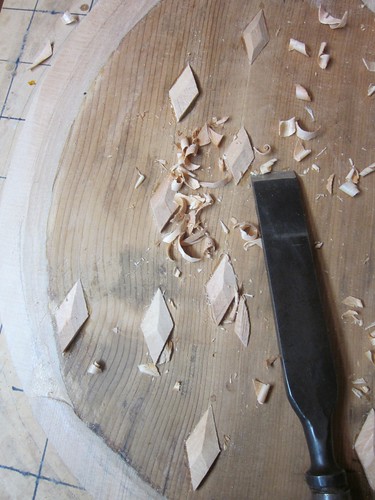 Very sharp blade essential!  Some more trimming will be done before I'm happy. Although this is work that only the angels will get to see I like to make sure it's done neatly. 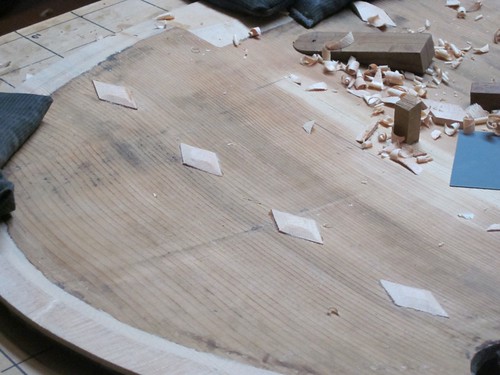 I might add a few more cleats later or some linen strips depending on how I feel. 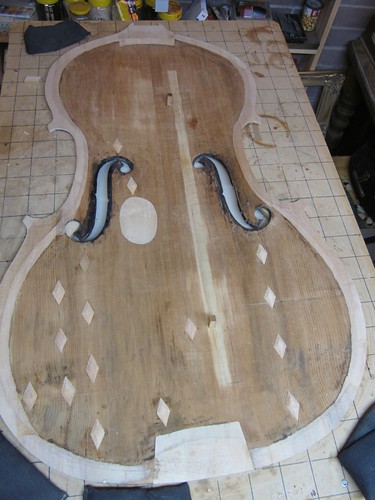 Here for comparison:  And here's a video of how i do it: http://www.youtube.com/watch?v=ZOayNxDvuPM |
|
#82
|
||||
|
||||
|
Nice - thanks for keeping us posted.
That's a beastly looking chisel!  |
|
#83
|
||||
|
||||
|
The chisel is the one I use for mortising a neck block, and I like its weight and the fact that it holds a razor edge really well. Not sure it's perfect for the job though - I'd be interested to see what other luthiers use for this task. I have a feeling that a paring chisel with a short wide blade would be even better.
|
|
#84
|
||||
|
||||
|
Personally I think a long, well balanced paring chisel would probably be choice; but like most things whatever is comfortable and sharp is going to work best, even if it isn't by the textbook...
 |
|
#85
|
||||
|
||||
|
Back to purfling repairs. Here are the main tools I use:
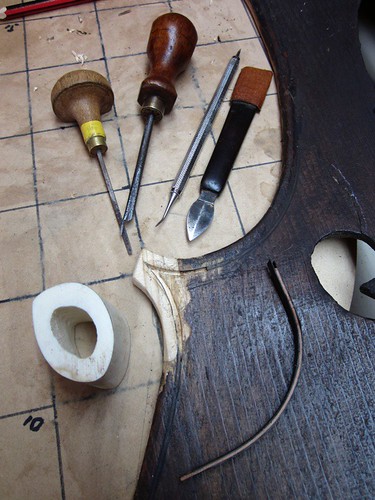 The job is exceedingly tedious and performed under a powerful magnifier; the original purfling is very brittle and has to be cut back to a suitable point, then the new beesting is cut following the original purfling lines ... and guessing a bit too. 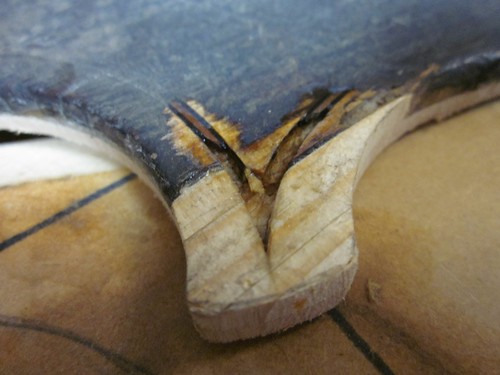 This is the first one I did, and I changed the way I do the scarf joints after this one. But it's OK.   This is more like dentistry than luthiery! It is difficult to match the edges of the purfling invisibly, even using a scarf joint. In this next corner I decided to make the joint in the purfling coincide with the grain lines; one is almost a butt, the other is a longish scarf. 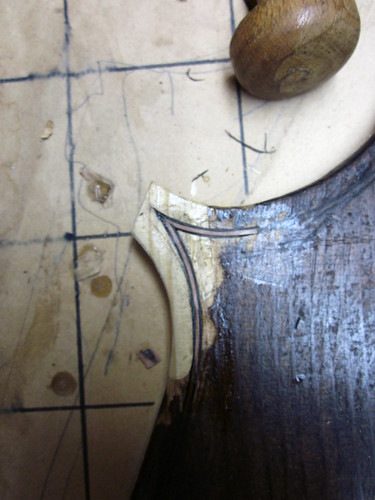 I think, under varnish, all these repairs will be virtually invisible. Ah the varnish. How the hell am I going to save the varnish? That's another problem. Last edited by Matthew Tucker; 11-09-2010 at 04:42 PM. |
|
#86
|
|||
|
|||
|
I've been following closely to your project. I think after all this work anyone would be lucky to have this instrument... Looks beautiful.
 |
|
#87
|
||||
|
||||
|
Its been a bit slow progress on this bass, as I've had a bunch of repair work on lately. However, the cleating is now finished and I've started to fit the bar.
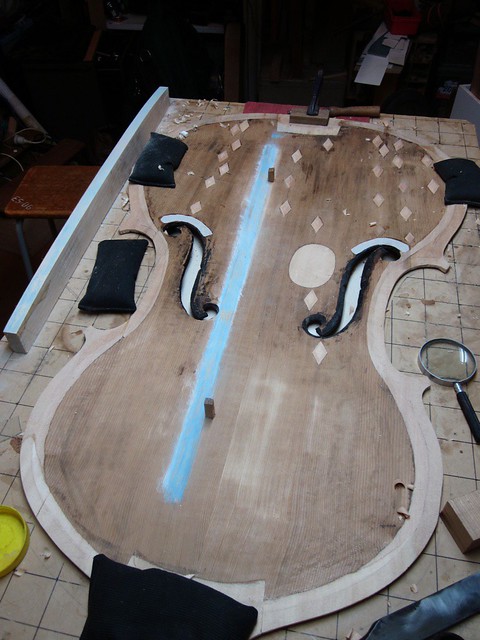 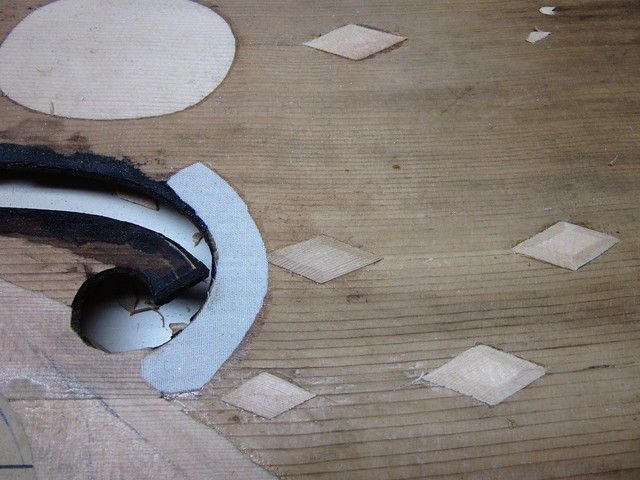 |
|
#88
|
|||
|
|||
|
Quote:
|
|
#89
|
||||
|
||||
|
Well, this hunk of timber needs to be replaced. It's going to be a time consuming and messy job pulling it out without damaging anything. I'm going to try to steam it all apart but if this gets too tricky I'll probably end up cutting it out.
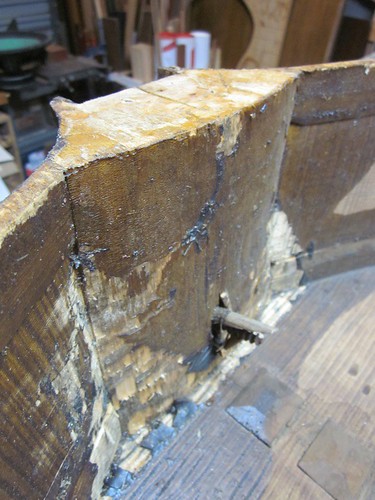  I found a bit more of the original varnish under a lot of dirt; it gives me the original colour, but there's no chance of recovering any of it on the ribs. 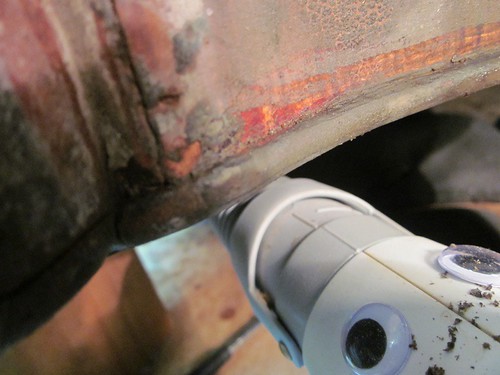 found some more metalwork holding the ribs on. Glad I found these before my blades did. 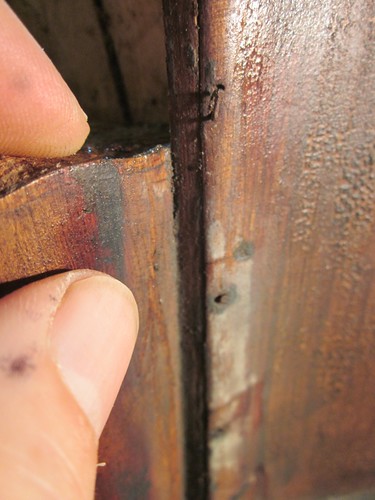 And yet MORE Metalwork ... 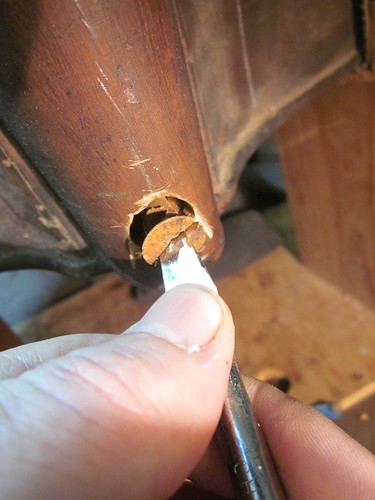 This is the wonderful screw I'm going to keep as a trophy! Pretty amazing that another hole was drilled right through the shank for the bolt that I originally extracted from the back of the button!  Loosening the neck block at the back seam. Look at all that stickiness:  Previous button repair came away. Some of it has been repaired with spruce, and there's a fair whack of putty in there too. I'm going to have to restore the whole button from scratch. 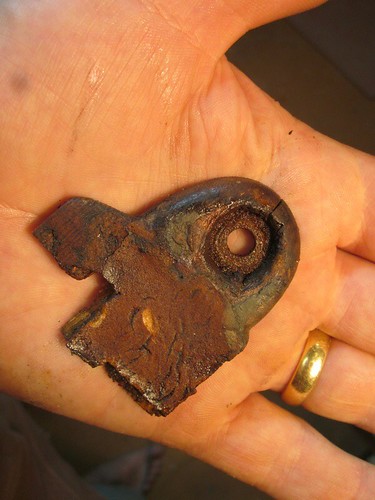 I got the old neck heel out sans trop de dégâts. The tear you can see on the right is the old spruce block that will be replaced entirely. Look at that lovely crack, subject to so much metalwork and dowelling in its lifetime! 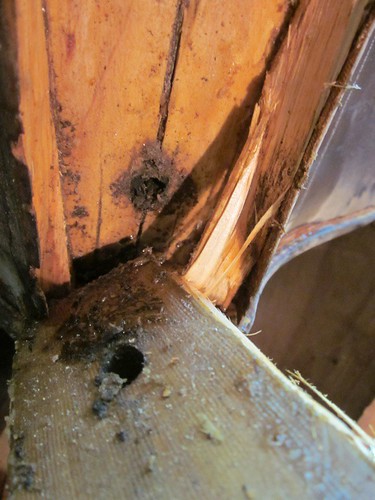 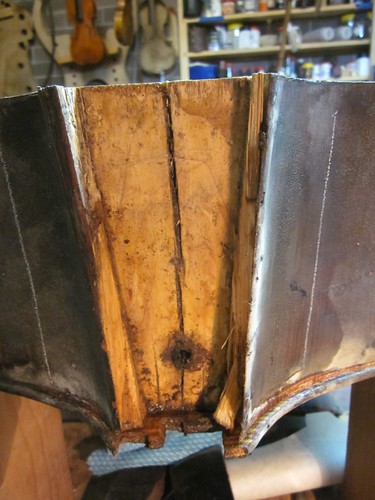 |
|
#90
|
|||
|
|||
|
I'm not a luthier, but I am REALLY enjoying this article. I am amazed at the stuff qualified people can tackle!
|
|
#91
|
||||
|
||||
|
+1. On the other hand, I am continually dismayed by the harm less-than-fully-qualified people can cause.
I look at that screw, with the hole drilled through it, and at the damage. I think of something a coworker used to say, grimly, when surveying the aftermath of others' messy efforts, "Men have been here before us. Men did this." Thank you, Matthew, for sharing all of this. |
|
#92
|
||||
|
||||
|
Quote:
 Thanks Matthew for the update - looking good! |
|
#93
|
||||
|
||||
|
I'm not quite sure what "qualified" means, actually. I have never apprenticed with anybody nor done any courses in luthiery let alone carpentry. However, I do seek out and - sponge-like - absorb knowledge, filter it, and store it away to use later in my own concoctions. And I love what I do.
Actually i suspect that many of the repairs on this bass, including the metalwork, were done by "qualified" luthiers. The holes were drilled accurately, the dowelling fit properly, certainly the screw through the heel was done neatly and finished with a proper wooden plug. I'm less impressed with the bolt through the button and the damage that caused to the button area. The nails around the rim ... well yes, that's an amateur repair. I think the problem with this bass may have been the choice of wood for the top block. Probably not quite dry enough and too close to the centre of the trunk; I suspect it cracked fairly early in the bass's life and everything since, the wobbly neck, the cracks in the top and ribs, the open seams, etc etc came about as a consequence. The only repair worth doing was a block replacement and that didn't happen; everything else was bound to fail at some point or other. I'm considering a laminated top block, and since I'm going to need to rebuild the neck/scroll from scratch or do a scroll graft, we may opt for a bolt-on neck as I have done for my other basses. |
|
#94
|
|||
|
|||
|
Thanks for the continuing updates on this project. I for one find it extremely interesting and informative. I've been around basses for 40+ years and have glued the odd seam, run some glue into a crack, filed nut and bridge slots-the sort of thing any bass owner should be able to do. A major restoration like this is a lesson in patience, planning, and most of all, attention to the smallest details. I eagerly await the next installment in the saga.
|
|
#95
|
||||
|
||||
|
Very small update to complete the picture - here's another shot of the original block with the grain lines highlighted. You can clearly see how it cracked, and why choice of the right wood for even the humble internal blocks is important for the longevity of a bass!
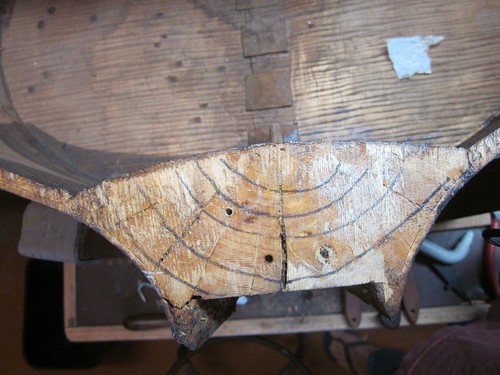 |
|
#96
|
||||
|
||||
|
Matt, I would like to point out that I have seen a few Basses with 2 piece blocks across the width as well as Laminated Blocks in the depth. Also, a few of my Basses that were restored had an added piece laminated for the depth to either deepen the neck set and strengthen the bottom of the block or due to the block being cut from the top to shorten the bass.
My Hart had it's original Blocks inside it when it was opened up. The upper and lower blocks were two pieced Pine. It seems that this was either done due to a shortage of materials or perhaps a method for stability. We will never know the actual 'why' these things were done in the past but if they survived 180 years, I think they got it right. In the case of this French Bass you are working on which looks to be a Mirecourt production rather then a makers individual single made bass, Blocks and other materials were used as they were supplied to the workers. I would assume that if the part was bad in the beginning, it would be tossed and not used but foresight in which what might survive the future or not was not a decision of a single worker. Also, from the looks of the condition of this bass being left alone for so long, dryness and stress combined can easily split any wide straight grained piece of wood like this Block. It can also split from the other pieces of wood glued to it as the weakest link is what usually gives. So, if you think this Bass needs some extra strength in the block material itself, two pieces glued of slightly different grain might help. Just my 2 cents, or 3 or 4..  Keep up the good work. I bet you can't wait for the next big job to walk into your shop huh?..lol |
|
#97
|
||||
|
||||
|
Well funny you should say that. Here's the new block all glued up
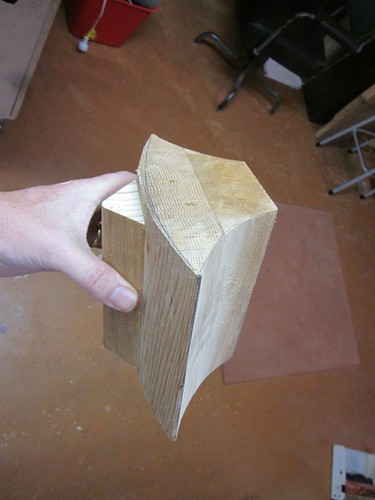 grain runs laterally across the bottom and vertically around the mortise. I'm still not 100% sure I'll use this one though. have to cogitate a bit. The next big job, I hope, is a new bass from scratch based on a Lott Sr pattern |
|
#98
|
||||
|
||||
|
Quote:
On the new Block, I can't see the grain of the upper piece but looks like it will do the Job, I would yeild the remainder of my time on this to Arnold who has seen more Blocks than I played with as a child..  Hey, on Lott Snr. there was new information published about him back in 1998. J.Lott Snr. was actually his father who was not a Luthier. J.F. Lott the Luthier was actually born in London (1776) and not in Germany as previously believed. Mis-information like this happens when the records searched come up with 2 people of the same name.The same thing happened with John Hart whose father of the same name was a Gunsmith and the Luther was erroneously thought to have opened a Gun Shop which was actually the Father who did. The son, John Thomas Hart, founder of Hart & Sons was given space in his Fathers shop a few years after the death of his master Samuel Gilkes. That is one of the published errors I believe due to father and son having the same name like with Lott who also had a son of the exact same name (b.1805) but thankfully with 3 John Lott's they called him Jack as a nick name, thankfully.  |
|
#99
|
||||
|
||||
|
Wayne - I'm not criticising anyone - who am I to know why something was done all those years ago!
The triangular block at the bottom is a bit of pine spot-glued on for clamping. I'll split it off when the ribs are clamped up. Ken, If John Lott the luthier had a son called John, then there would be TWO John Lott Seniors in the mix! There sure are a Lott of them  |
|
#100
|
||||
|
||||
|
Quote:
Hi son John (jack) Lott II (b 1814) was the colourful character who was also a luthier who learnt his stuff from his father, then later in Richard Davis's shop, and then later went on to be elephant trainer and rascal, and then luthier again expert with a reputation as expert copyist. I read a great anecdote where J Lott II made two violins, "dirtied them up" a little, put them in a couple of old cases and sold them at market for 60 pounds each. This really pissed his father off, who hated the false antiquing tricks, so he (J Lott I) made two beautiful new violins, took them to the same market ... and couldn't sell them. Thus began the parting of their ways ... Thomas Martin's article says that John Lott II worked in Dodd & Metzler's shop on an outwork basis. It appears that both father and son worked in the same Shop. In the end it doesn't really matter though for me who designed the "Lott" bass I wat to build. It has lovely proportions and those big blunt-ended corner blocks. Last edited by Matthew Tucker; 01-13-2011 at 06:30 AM. |
 |
| Currently Active Users Viewing This Thread: 2 (0 members and 2 guests) | |
| Thread Tools | |
| Display Modes | |
|
|